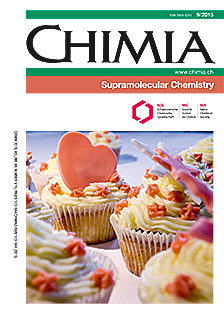Synthetic G-Quartets as Versatile Nanotools for the Luminescent Detection of G-Quadruplexes
DOI:
https://doi.org/10.2533/chimia.2015.530Keywords:
Dota, G-quadruplexes, Luminescence, Pyrene, Tasq, TerbiumAbstract
Recent years have witnessed a tremendous increase in the biotechnological applications of nucleic acid-based nanotools. Beyond their biological relevance, nucleobases have indeed found new scopes of applications in bionanotechnology, which are expanding nowadays at an accelerated pace. Among the four canonical nucleobases (adenine, guanine, cytosine and thymine), guanine is certainly the most useful and used base, thanks to its versatile H-bond donating/accepting properties that make it suitable for being involved in various assemblies ranging from base-pairs to base-quartets. Here, we would like to report on an innovative guanine-based molecular tool named Tb. Pyro-DOTASQ: this metal complex has a sophisticated chemical structure that allows formation of an intramolecular G-quartet upon interaction with alternative secondary structures known as G-quadruplexes. This target-promoted molecular switch triggers a luminescence response that would permit the use of Tb. Pyro-DOTASQ to search and detect quadruplex-forming DNA and RNA sequences: its unique design indeed allows it i) to create specific interaction with quadruplexes, ii) to provide an easily readable luminescent output to monitor this association and iii) to be readily immobilized on graphene surface, thus making Tb. Pyro-DOTASQ a high-value molecular device. Results obtained in the course of in-depth biophysical analyses raise questions about the actual supramolecular structure of Tb. Pyro-DOTASQ: these results thus shed a bright light on the care that must be exercised when using intricate molecular architectures to construct elaborated supramolecular metal complexes.Downloads
Published
2015-09-30
Issue
Section
Scientific Articles
License
Copyright (c) 2015 Swiss Chemical Society

This work is licensed under a Creative Commons Attribution-NonCommercial 4.0 International License.
How to Cite
[1]
A. Laguerre, M. Levillain, L. Stefan, R. Haudecoeur, F. Katranji, M. Pirrotta, D. Monchaud, Chimia 2015, 69, 530, DOI: 10.2533/chimia.2015.530.







